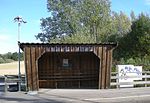Fetsund Station
1862 establishments in NorwayNorwegian railway station stubsRailway stations in Fet, NorwayRailway stations in Norway opened in 1862Railway stations on the Kongsvinger Line

Fetsund Station (Norwegian: Fetsund stasjon) is a railway station located in Fetsund in Fet, Norway on Kongsvinger Line. The station was built as part of the Kongsvinger Line in 1862. The station is served hourly, with extra rush hour departures, by the Oslo Commuter Rail line R14 operated by Vy.
Excerpt from the Wikipedia article Fetsund Station (License: CC BY-SA 3.0, Authors, Images).Fetsund Station
Gamle Fetvei, Lillestrøm
Geographical coordinates (GPS) Address Nearby Places Show on map
Geographical coordinates (GPS)
| Latitude | Longitude |
|---|---|
| N 59.927222222222 ° | E 11.163055555556 ° |
Address
Fetsund
Gamle Fetvei
1900 Lillestrøm
Norway
Open on Google Maps







